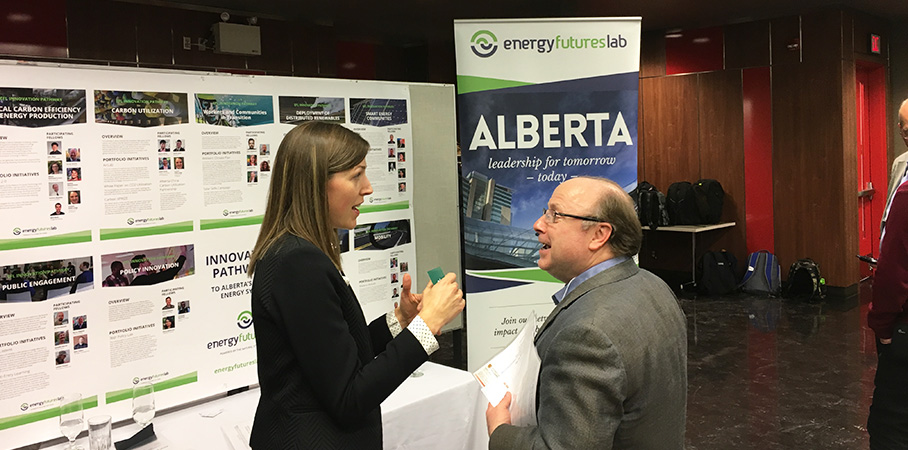
On December 5, 2016, approximately 170 people braved the cold to talk about the future of energy in Alberta at the University of Calgary’s downtown campus.
Dr. David Layzell, Energy Futures Lab (EFL) Steering Committee Member and Director of the Canadian Energy Systems Analysis Research (CESAR) project, argued that energy system transition is the “grand challenge for our society.”
The EFL design team worked with Dr. David Layzell and his research group to help identify big challenges and opportunities for energy transition in Alberta.
He indicated three components of our energy system that we can leverage for transition:
- the technologies we use to deliver energy services;
- the fuel we use; and
- our behaviour.
Not coincidentally, these three leverage points map to the EFL Innovation Pathways and portfolio of initiatives. The EFL design team worked with Dr. David Layzell and his research group, namely Song Sit, Senior Associate and Bastiaan Straatman, Energy Systems Modeller, to help identify big challenges and opportunities for energy transition in Alberta. Student teams then modelled 10 different scenarios for the future of energy in the province.
Deploying Distributed Energy
One of the EFL pathways is about the Deployment of Distributed Renewables. Led by Fellow Alison Thompson, one of the initiatives in this pathway investigates the renewable power and heat potential from over 400,000 wells in Alberta. Two of the student projects provided more data to complement this initiative.
The first group found that power generated from “depleted Steam Assisted Gravity Drainage (SAGD) heat recovery can reduce emissions associated with electricity use in the SAGD sector by up to 28%” [1]. The second group focused on geothermal heating from wells to offset burning of natural gas for home and commercial space heating. Using Red Deer as a sample area, the student group suggests that this form of heating is possible and could be extended to include “geothermal space heating in work camps and warehouses” [2].
Mobility
The Mobility pathway is about dramatically reducing energy used for the movement of people and goods. EFL Fellows in this pathway are working on a waste-to-biofuels initiative. A few transportation related projects at the CESAR event also investigated technology, fuel and behaviour as leverage points for energy transition. One group investigated the conversion of biomass residues from agriculture and forestry to Dimethyl Ether (DME). This could potentially replace a portion of diesel fuel consumed by the freight industry and significantly reduce emissions. The team discovered a potential 11 megatonne per year reduction [3].
Another group took a very different approach, focusing on energy demand and the following question: “What if energy demand characteristics were changed by a new generation?”[4]. The group investigated how Gen Y and Millennials think about housing and transportation i.e. their inclination to share cars and use public transit as well as live in urban centres and choose smaller spaces. How do these behaviours impact energy use? By being a Millennial team, the group had a head start on their research. They found a “potential 8.4 megatonnes of CO2 equivalent reduction associated with higher density living” [4], which could be a significant contribution to Alberta’s emissions reduction target.
Next Steps
The EFL plans to continue working with Dr. Layzell, his team at CESAR and students in future years. The data from student research is already helping the EFL teams focus their efforts and uncover new opportunities.
[1] Heat Recovery From Depleted SAGD Reservoirs To Generate Green Electricity. S. Amin, K. Bexte, T. Pickett, E. Waldson, T. Zhao. University of Calgary, 2016.
[2] Geothermal Potential in Alberta: Direct Heat from Oil and Gas. S. Clarke, L. Bassett, R. Shcarein, A. Vo, N. Loucks. University of Calgary, 2016.
[3] Fuel from Biomass Residues. J. Fedrau, L. Beaton, M. Tashnil, N. Delorme, U. Kamran. University of Calgary, 2016.
[4] What If Millenials Transformed Energy Demand? Effects of High Density Community Lifestyles on GHG Emissions. A. Zalazar, J. Le, R. Branchaud, N. Fergus, M. Bello. University of Calgary, 2016.

Steve Williams is a technology strategist designing and facilitating participant-driven public engagement events with over 20 years experience in the software industry.



